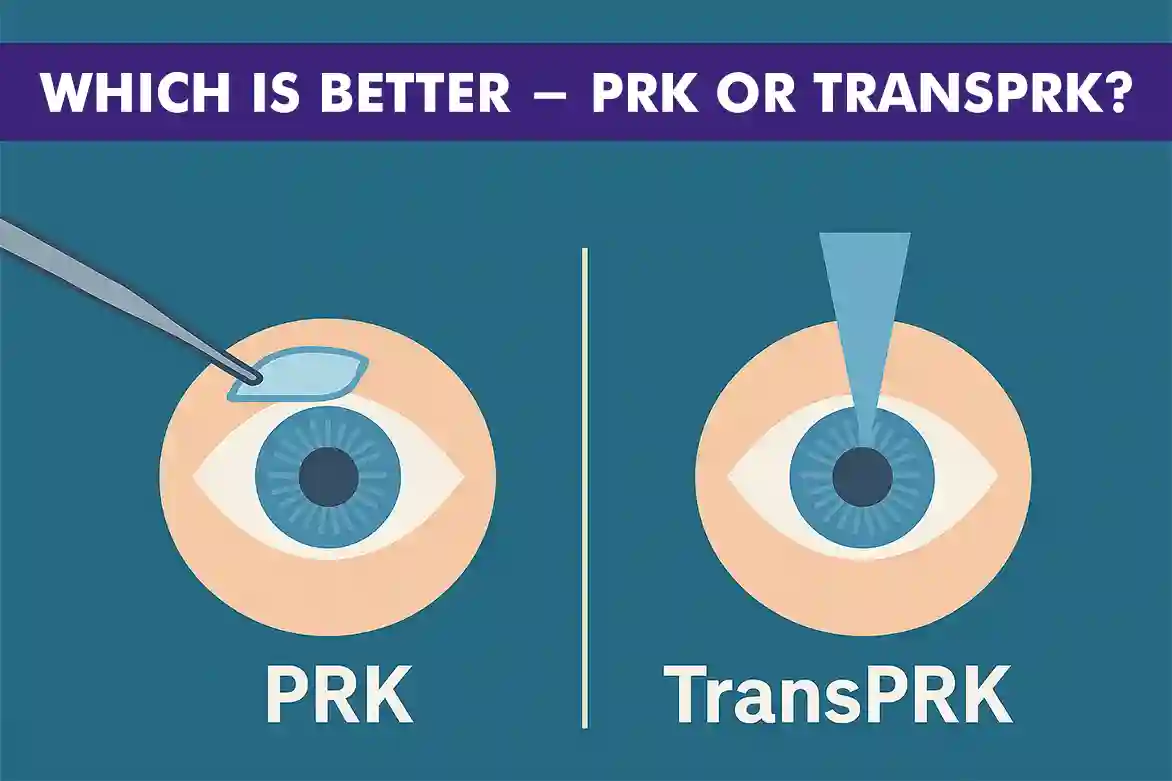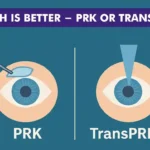Choosing the right laser vision correction procedure can be a daunting task, especially with the variety of options available today. Among these, PRK (Photorefractive Keratectomy) and TransPRK (Transepithelial Photorefractive Keratectomy) are two popular choices for refractive eye surgery. Both aim to correct refractive errors and improve vision, but they do so in slightly different ways.
In this guide, we will delve into the details of both procedures, compare their benefits and drawbacks, and help you decide which one might be the best option for your specific needs.
Understanding PRK: The Basics
PRK, or Photorefractive Keratectomy, is a refractive surgery designed to correct vision problems such as myopia, hyperopia, and astigmatism by reshaping the cornea. This procedure, which has been utilized since the 1980s, was the first type of laser eye surgery for vision correction. Here is a detailed, step-by-step explanation of the PRK process:
- Preparation: Before the procedure begins, the patient is given anesthetic eye drops to numb the eye and minimize discomfort. The patient is then positioned under the laser, and a speculum is used to keep the eyelids open.
- Removal of the Epithelium: The first step in PRK involves the removal of the cornea’s outermost layer, known as the epithelium. This can be done using a special brush, blade, or alcohol solution to gently loosen and remove the cells.
- Laser Reshaping: Once the epithelium is removed, an excimer laser is used to precisely reshape the underlying corneal tissue. The laser is programmed based on the patient’s specific vision correction needs, and it removes microscopic amounts of tissue to alter the cornea’s curvature.
- Focusing Light: By reshaping the cornea, the procedure allows light entering the eye to be focused more accurately onto the retina, which results in clearer vision.
- Healing and Recovery: After the laser treatment, a soft contact lens is placed over the cornea to act as a bandage, protecting the eye and aiding in the healing process. The epithelium naturally regenerates over the course of a few days.
- Follow-Up Care: Patients are typically prescribed medicated eye drops to prevent infection and reduce inflammation. Follow-up appointments are scheduled to monitor the healing process and ensure the eye is recovering properly.
This step-by-step approach to PRK helps to correct refractive errors and improve vision, offering a reliable solution for those seeking laser eye surgery.
Diving into TransPRK: The Advanced Approach
TransPRK, or Transepithelial Photorefractive Keratectomy, is an advanced form of vision correction surgery that builds upon the principles of PRK. This procedure is unique because it is entirely laser-based, eliminating the need for any manual intervention to remove the corneal epithelium. Here is a detailed, step-by-step explanation of the TransPRK process:
- Preparation: Before the procedure begins, the patient receives anesthetic eye drops to numb the eye, ensuring comfort throughout the surgery. The patient is then positioned under the laser, and a speculum is used to keep the eyelids open.
- Laser Removal of the Epithelium: Unlike traditional PRK, where the epithelium is manually removed, Trans PRK uses a laser to perform this step. The laser gently and precisely removes the outermost layer of the cornea, known as the epithelium, in a seamless and continuous manner.
- Laser Reshaping of the Cornea: Immediately following the removal of the epithelium, the same laser is used to reshape the underlying corneal tissue. This is done according to the patient’s specific vision correction needs. The laser removes microscopic amounts of tissue to alter the cornea’s curvature, allowing for improved focus of light onto the retina.
- Focusing Light: By reshaping the cornea, the procedure enables light entering the eye to be focused more accurately onto the retina, resulting in clearer vision.
- Healing and Recovery: After the laser treatment, a soft contact lens is placed over the cornea to serve as a protective bandage, aiding in the healing process. The epithelium naturally regenerates over the course of a few days.
- Follow-Up Care: Patients are typically prescribed medicated eye drops to prevent infection and reduce inflammation. Follow-up appointments are scheduled to monitor the healing process and ensure the eye is recovering properly.
This method is considered less invasive than traditional PRK and often results in a quicker recovery time, with many patients experiencing significant vision improvement in just a few days.
Key Differences Between PRK and TransPRK
| Aspect | PRK (Photorefractive Keratectomy) | TransPRK (Transepithelial Photorefractive Keratectomy) |
| Epithelial Removal | Manual removal using a brush, blade, or alcohol solution. | Laser-based removal, eliminating the need for manual intervention. |
| Invasiveness | More invasive due to manual removal of the epithelium. | Less invasive as the laser performs both epithelial removal and corneal reshaping. |
| Recovery | Typically involves more discomfort | Generally associated with less |
| Process | and a longer healing period. | discomfort and a faster recovery time. |
| Healing Time | Vision stabilization may take several weeks. | Vision often stabilizes within a few days to a week. |
| Procedure Complexity | Involves multiple steps with manual intervention. | Streamlined process with continuous laser application. |
These differences highlight the unique approaches of PRK and TransPRK, with Trans PRK offering a more advanced, less invasive option that may lead to quicker recovery and reduced discomfort.
Benefits and Drawbacks of PRK
Benefits of PRK:
- PRK has a long track record of success and is particularly suitable for patients with thinner corneas or those who are not candidates for LASIK.
- It is a well-established procedure that can effectively correct a range of refractive errors, offering a reliable solution for improved vision.
- PRK does not involve creating a corneal flap, eliminating the risk of flap-related complications.
Drawbacks of PRK:
- The recovery process can be more uncomfortable, with patients often experiencing significant discomfort and sensitivity to light.
- It might take longer for vision to stabilize compared to other procedures, sometimes requiring several weeks.
- The initial healing period can involve blurred vision and the need for frequent follow-up visits to monitor progress.
Why Choose TransPRK: Pros and Cons
Pros of TransPRK:
- Less Invasive: Trans PRK is a less invasive procedure as it uses a laser to remove the epithelium, eliminating the need for manual intervention.
- Reduced Discomfort: Patients generally experience less discomfort during the recovery process compared to traditional PRK.
- Faster Recovery: The recovery time is typically quicker, with many patients noticing significant vision improvement within a few days.
- No Flap Complications: Since there is no creation of a corneal flap, the risk of flap-related complications is eliminated.
- Suitable for Thinner Corneas: TransPRK can be a viable option for patients with thinner corneas who are not candidates for LASIK.
Cons of TransPRK:
- Higher Cost: TransPRK may be more expensive than traditional PRK due to the advanced technology involved.
- Limited Availability: Not all vision correction centers offer TransPRK, which might limit accessibility for some patients.
- Insurance Coverage: Some insurance plans may not cover the cost of TransPRK, leading to higher out-of-pocket expenses.
- Longer Procedure Time: The procedure might take slightly longer due to the continuous laser application for both epithelial removal and corneal reshaping.
Recovery Time Comparison: PRK vs. TransPRK
The post-surgery journey following PRK can be quite challenging, as it typically involves a significant amount of discomfort and a prolonged healing period. Patients often experience sensitivity to light and blurred vision, requiring patience as their eyes gradually adjust. The healing process can extend over several weeks, during which vision slowly stabilizes, necessitating regular follow-up visits to monitor progress and ensure proper recovery.
In contrast, the recovery experience after TransPRK is generally smoother and more rapid. Many patients report a noticeable improvement in their vision within just a few days, accompanied by less discomfort compared to PRK. The advanced laser technology used in TransPRK minimizes invasiveness, allowing the corneal epithelium to regenerate more swiftly. This leads to a quicker return to daily activities, with vision stabilizing much sooner, often within a week. The journey post-TransPRK is marked by a sense of relief and satisfaction as patients enjoy clearer vision with minimal disruption to their routine.
Conclusion
Both PRK and TransPRK are effective vision correction procedures, each with its own set of benefits and drawbacks. Your choice will depend on various factors, including your specific vision needs, corneal thickness, and budget.
Consulting with a qualified ophthalmologist will help you determine which procedure is best suited for you, ensuring that you achieve the best possible outcome for your vision.
FAQs
Both PRK and TransPRK are considered safe procedures with high success rates, but TransPRK might offer a slight edge in terms of reduced discomfort and faster recovery.
TransPRK generally causes less pain during recovery compared to PRK, as it is less invasive.
Vision typically stabilizes faster after TransPRK, often within a few days to a week, while PRK might take several weeks.
Long-term results for both procedures are generally excellent, with most patients achieving 20/20 vision or better.
Yes, if you are not a candidate for LASIK, you might still be eligible for TransPRK, especially if you have thinner corneas.





